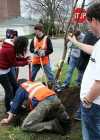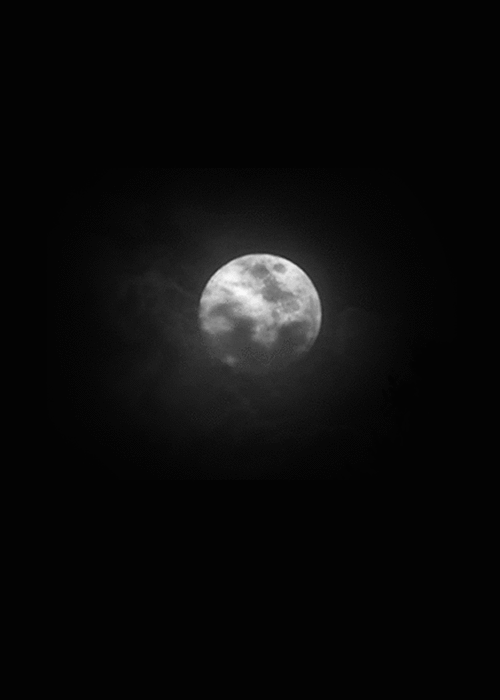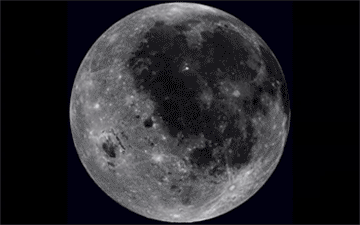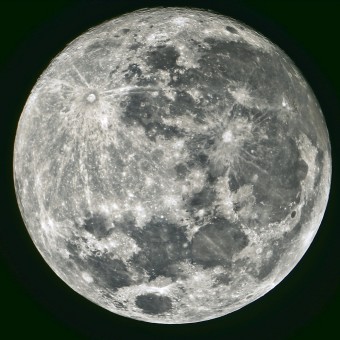Teach Your Children to Save Day is an educational program that was established by the American Bankers Association (ABA), with the aim of encouraging kids to develop a good savings habit as early as possible in their financial life. This is done through banking volunteers giving presentations to school kids to teach them specifically about saving money, but also about other financial matters such as spending, donating and investing. Volunteers can find out how to get involved through the ABA, with the association having teaching materials available that can be used as a starting point for preparing a fun and interesting talk.
Word of the Day
| |||
| Definition: | (adjective) Endowed with feeling and unstructured consciousness. | ||
| Synonyms: | animate | ||
| Usage: | The living knew themselves just sentient puppets on God's stage | ||

History
| |||
 | De Kooning was a Dutch-American painter who became a leader of abstract expressionism, the New York-based school of painting that rejected naturalistic content. Examples of this period include his dramatic Black Paintings, which were black-and-white artworks created from enamel and oil paints. His later work became increasingly figurative, as is seen in his The Woman series of the 1950s, and was both criticized and lauded. | ||
| |||
 | Julius Sterling Morton (1832-1902), one of the earliest American conservationists, settled on the treeless plains of Nebraska in 1855. Morton began planting trees and urged his neighbors to do the same. On April 10, 1872, when he proposed that a day be set aside for planting trees, the response was overwhelming: a million trees were planted in Nebraska on that day alone. All 50 states now observe Arbor Day—usually on the last Friday in April. Most observances take place in public schools, where the value of trees is discussed and trees and shrubs are planted. | ||
| |||
| Flitting from blossom to blossom, bees represent an ecological lifeline from one generation of plants to the next – paid in nectar and pollen to keep the reproductive ball rolling on farms, in woods, and.in backyard gardens. | |||
READ MORE:
1833 - A patent was granted for first soda fountain.
1897 - William Price became the first to be named White House news reporter.
1953 - Winston Churchill was knighted by Queen Elizabeth II.
1962 - MIT sent a TV signal by satellite for the first time.
1969 - Paul McCartney says there is no truth to rumors he is dead
73, Today

Glasses, Stolen from Museum
MEMPHIS, Tenn. (AP) — Officials say a pair of Elton John’s heart-shaped
glasses has been stolen from a display case at a Memphis museum.
glasses has been stolen from a display case at a Memphis museum.
Memphis police said Wednesday the glasses were taken from the Memphis
Rock n’ Soul Museum. Officers were called to the museum Tuesday night,
when employees noticed the glasses were missing.
Rock n’ Soul Museum. Officers were called to the museum Tuesday night,
when employees noticed the glasses were missing.
Officers said the case holding the glasses sustained no real damage. Police
said a museum manager told officers someone would have to use a set of
tools to remove the item from the case. An officer processed the case for
fingerprints.
said a museum manager told officers someone would have to use a set of
tools to remove the item from the case. An officer processed the case for
fingerprints.
Museum executive director John Doyle says these glasses are valued at
about $2,000. No arrests have been made, and the search for the glasses
continues.
about $2,000. No arrests have been made, and the search for the glasses
continues.

THE DAILY SQU-EEK

If You Were Born Today, April 24
You are a determined person and you intuitively know that with patience, you can accomplish anything you set out to do. You easily earn respect from others around you, due in part to your regal manner. Your family is extremely important to you, and many of your values are quite traditional, which keeps you grounded and responsible. However, you are unafraid of embracing the new, even if you do so slowly. Famous people born today: Shirley MacLaine, Barbara Streisand, Kelly Clarkson.
| Picture of the day | |
 | |
An Armenian woman kneeling beside a dead child in a field during the Armenian Genocide, conducted by the government of the Ottoman Empire. The genocide is conventionally held to have begun on 24 April 1915, when Ottoman authorities arrested and later executed some 250 Armenian intellectuals and community leaders. Much of the remaining Armenian population were deported into the deserts of Syria, where most died from starvation, exhaustion, and systematic massacres. The total number of people killed has been estimated at between 1 and 1.5 million. Though the events are widely recognized as a genocide by historians, the Turkish government rejects such a description.
| |

Christmas in Kolkata
Photograph by Abir Choudhury, National Geographic
Families celebrate under a corridor of twinkle lights on Christmas Eve in Kolkata’s Bow Barracks. “This auspicious occasion is celebrated in a very colorful way,” writes Abir Choudhury. “I [tried] to highlight them with black and white.”

knit
Bike Seat Cover #L20400 pattern by Lion Brand Yarn
A quick knit with one skein of Tweed Stripes, this bicycle seat cover utilizes a self-striping yarn to create a stunning visual effect. What a perfect gift for the ...
| |||||||
knit
knit
knit
knit
Ripple Cuffs pattern by Frankie Brown
These cuffs fit snugly over the wrist and then open out into rippled bands. They are easy to knit, either in the round or flat and then seamed, and use only 30...
| |||||||
crochet
RECIPE
CROCKPOT RECIPE
stephanie o'dea
American Chop Suey (Macaroni and Beef) Slow Cooker Recipe
I had never heard of American Chop Suey before Amy Jo sent me an email wondering if it could be made in a slow cooker. She first learned of the dish on an episode of Diners, Drive-Ins, and Dives. I looked the name up on Wikipedia and learned that it seems to be a regional thing---sometimes it's called Macaroni and Beef, and it appears that it was the inspiration behind Hamburger Helper. Huh! I love learning new things.
The Ingredients.
serves 6
1 pound lean ground beef, browned and drained
5 bacon strips, diced
1 large onion, diced
1 green bell pepper, seeded and diced
1 (14.5-ounce) can diced tomatoes --- any flavor, or plain
1 can water (empty tomato can)
6 garlic cloves, chopped
1 (26-ounce) jar prepared pasta sauce
1 (16-ounce) package elbow macaroni (I used brown rice pasta)
1 cup shredded cheddar cheese (optional)
The Directions.
Use a 6-quart slow cooker. In a large skillet, brown the beef, bacon and onion all together until the meat is no longer pink. Drain well and plop into your slow cooker. Add everything else into the pot except for the pasta and cheese.
Stir to combine. Cover and cook on low for 6 to 8 hours, or high for about 4. Stir in the raw pasta and cook on high for approximately 30 minutes, or until pasta is bite-tender. Serve in a wide-mouthed bowl with a handful of cheese on each serving.
The Verdict.
Amy Jo, thank you so much for letting me know about this dish! The slight smokiness from the bacon really flavors the meat well, and I loved how the pasta cooked in the pot and swelled nicely to create a wonderful casserole. The serving sizes are generous, here---I had a bunch left that I shared with my friend Lorraine and her family. My girls and Lorraine's girls all really liked the pasta with meat sauce. Success! The leftovers taste great the next day, but the texture is different, and something to note. You'll find that the pasta really breaks down overnight and soaks up a lot of the moisture.

PUZZLE
CRAFT

CHILDREN'S CORNER ...




Corals on Flynn Reef
QUOTE

ORB WEAVER SPIDER
This Orb Weaver spider spins webs in intricate geometric patterns. How cool is nature!?

'where's the bathroom?' in Turkish - Tuvalet nerede?

CLEVER
take this quiz meant for adults regarding science (i got 12 out of 13)

Jaw of a shortfin mako shark
EYE OPENER
WHY THE SAME SIDE OF THE MOON ALWAYS FACES THE EARTH
One Moon “day” is approximately 29 1/2 Earth days. This rotation coincides with its orbit around the Earth so that we only see about 59% of the surface of the Moon from Earth. When the Moon first formed, its rotational speed and orbit were very different than they are now. Over time, the Earth’s gravitational field gradually slowed the Moon’s rotation until the orbital period and the rotational speed stabilized, making one side of the Moon always face the Earth.
How does this work? Simply put -tidal friction. For a slightly less simple explanation, we’ll have to put our science caps on. But stick with it; it’s fascinating. I promise.
To start, think of how the Moon causes major tides on the Earth due to the Moon pulling at the Earth via its gravitational field. The Earth has this same effect on the Moon and, being 81.28 times more massive, the effect is much more powerful.
So, as the mass of the Moon is attempting to go one way (in a straight line), the Earth is simultaneously pulling it another way (towards the Earth). Further, the effect of the Earth’s gravitational field is stronger on the side of the Moon closest to the Earth than on the far side (and the same with the Moon’s gravitational field’s effect on the different parts of the surface of the Earth).

This combination essentially stretches the Earth and Moon, creating tidal bulges on both celestial bodies. This occurs on both sides of each, with the bulge on the sides closest together from gravity and on the sides farthest away from inertia. In the latter case, the matter is less affected by the gravitational force with inertia dominating in this instance. To put it another way, the matter is trying to move in a straight line away from the Earth and the gravitational forces here aren’t as strongly able to overcome this, which creates the bulge on that side.
So back before the Moon was tidally locked with the Earth, the bulge on the side of the Moon nearest to Earth ended up slightly leading thanks to friction and the fact that the Moon rotated faster than its orbital period around the Earth. So with this slightly leading bulge being offset from the line of gravitational pull between the Moon and Earth, this created a torque, which overtime resulted in the Moon’s rotation slowing until it became tidally locked with the Earth; thus, only one side faces the Earth. (Note: the bulge on the far side of the Moon had the opposite effect, but the bulge closest to the Earth dominated the interaction.)

You’ll note, though, that I said we actually get to see about 59% of the surface of the Moon from Earth, not 50%. The discrepancy comes from the fact that the Moon’s orbit around the Earth isn’t perfectly circular, more of an ellipse. As the Moon’s distance from the Earth increases and decreases, its angular speed changes, while its rotational speed stays the same. The result is that we get to see an extra 9% of its surface than we would if it had a perfectly circular orbit.
The other side of this, as you may have guessed, is that the Moon has the same effect on the Earth and is gradually slowing the Earth’s rotation in the exact same way the Moon became tidally locked with the Earth. Further, as the Moon slows the Earth’s rotation, a small portion of the Earth’s rotational momentum gets transferred to the Moon’s orbital momentum, with the result being that the average radius of the Moon’s orbit increases at about 3.8 centimeters per year with the current continental positions and barring major geological events. (Contrary to what you’ll often read, the Moon isn’t getting all the energy here, most of it is being converted to heat via friction, with only an estimated 3% of the energy in the interaction being “stolen” by the Moon.)

Thus, the distance between the Moon and the Earth changes gradually and is more or less in step with the rotational period change. It should be noted, though, that it’s not a constant change as things like major earthquakes, glacial changes, continental drift, and other such geological events play a role here, which is why leap seconds aren’t added at regular intervals, but only when needed. But the overall effect is that over time, the Moon is getting farther and farther away from the Earth every year, while the Earth’s rotation is slowing down.
In theory, at some point tens of billions of years from now (with the exact timeframe being extremely difficult to nail down due to so many unknowable factors) the same side of the Earth will always face the Moon, with the Earth only rotating once per lunar cycle, which at that point most estimates indicate should be about 47 current Earth days long.

“In theory”… but this will likely never happen. Why? In about 1 to 2 billion years or so, the Sun’s brightness will have increased sufficiently to vaporize all water on the surface of the Earth, getting rid of the ocean tides altogether, which is a huge factor in this interaction. However, there still would be some bulging of the Earth’s crust to continue the process to a much lesser extent.
In 5 to 6 billion years, the Sun will be around the peak of its Red Giant phase, and according to the latest models, even with the Sun losing quite a bit of mass during this process, thus making the Earth’s orbit farther out, the Sun should just barely consume the Earth and Moon many billions of years before such a dual tidal lock can occur.

Bottom line, at some point in the next billion years or so, humans will need to either find another home, or figure out how to manually move our current one to a farther out orbit, keeping Earth in the habitable zone of our solar system.



























Son in OR is awaiting the eclipse. We've had such cold nights and great skies lately so we've had a lot of celestial moments!
ReplyDeleteI can relate to the QUOTE ... my floor needs hugs regularly. :)
ReplyDelete